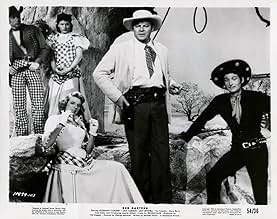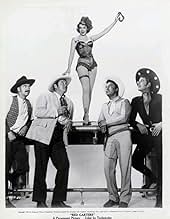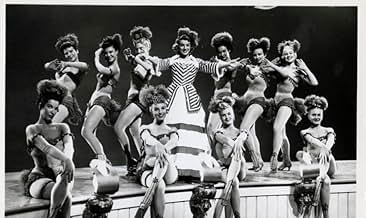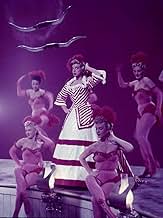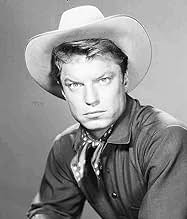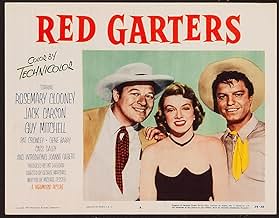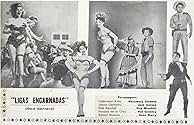Füge eine Handlung in deiner Sprache hinzuA man visits a frontier town seeking to avenge his brother's murder.A man visits a frontier town seeking to avenge his brother's murder.A man visits a frontier town seeking to avenge his brother's murder.
- Regie
- Drehbuch
- Hauptbesetzung
- Für 1 Oscar nominiert
- 1 Nominierung insgesamt
Bill Alcorn
- Dancing Townsman
- (Nicht genannt)
Jerry Antes
- Dancing Townsman
- (Nicht genannt)
Herman Boden
- Dancing Townsman
- (Nicht genannt)
Jack Boyle Jr.
- Dancing Townsman
- (Nicht genannt)
Jimmy Brooks
- Dancing Townsman
- (Nicht genannt)
Ian Bruce
- Dancing Townsman
- (Nicht genannt)
Empfohlene Bewertungen
For a change of pace - If you sometimes enjoy watching a "slap-happy" musical from Hollywood's heyday - Then - "Red Garters" is a Technicolor dream-come-true that really kicks up its heels.
Released back in 1954 - "Red Garters" is a clean and wholesome Western spoof that is imaginatively presented in the stylized fashion of an extravagant Broadway musical production.
In this singin', dancin', and romancin' comedy - (singer) Rosemary Clooney certainly gets plenty of opportunity to belt out a number of tunes that were specially scored to showcase her excellent vocal talents.
All-in-all - "Red Garters" is a high-energy musical production that is sure to please.
Released back in 1954 - "Red Garters" is a clean and wholesome Western spoof that is imaginatively presented in the stylized fashion of an extravagant Broadway musical production.
In this singin', dancin', and romancin' comedy - (singer) Rosemary Clooney certainly gets plenty of opportunity to belt out a number of tunes that were specially scored to showcase her excellent vocal talents.
All-in-all - "Red Garters" is a high-energy musical production that is sure to please.
I'd been interested in this musical for a long time in view of its famously stylized look – bright yellow scenery, disembodied sets – which, in hindsight, is still the film's major asset (though, curiously, it's taken for granted throughout and never once commented upon!). The cast is low-key but undeniably engaging: lovely Rosemary Clooney is delightful and surprisingly sensuous at times (although the title's promise of naughtiness is not carried through); Jack Carson is amusing as her loudmouth womanizing beau (atypically, he's the object of Clooney's affection throughout); Guy Mitchell is the gauche stranger hero looking for his crook brother's murderer – simply because the Code Of the West, whom everyone takes off his hat to (which, actually, reminds me of a very funny Tex Avery cartoon!), demands it – and who falls for Carson's sheltered ward; and Gene Barry(!) as the archetypal Latin lover who strikes up an unlikely partnership with Mitchell (while, naturally, having his own romantic complications over the daughter of a judge from out-of-town played by veteran Reginald Owen).
Frank Faylen – emerging as the real villain of the piece – is typically weaselly, while Buddy Ebsen appears briefly as a bartender (but who still gets his own specialty number and is involved in an amusing fade-out gag); besides, there's resistible (but not particularly intrusive) comedy relief courtesy of a squaw character. After a funny introduction, too, Mitchell's horse – who hates its own species and really thinks itself human! – is simply forgotten about for the rest of the film. There are a couple of nice spoofs of barroom brawls and duels, but rather too many ensemble dance routines which don't really add anything new to the fold. The songs, while not especially memorable, are nonetheless fine – ironic and intimate as the case may be but the plot itself is rather blah. The whole, then, is somehow less than the sum of its parts – if still highly enjoyable, even endearing; in retrospect, it's a pity that RED GARTERS has been overshadowed by other contemporaneous Western musicals such as ANNIE GET YOUR GUN (1950), CALAMITY JANE (1953) and OKLAHOMA! (1955).
Clooney, who also co-starred in WHITE Christmas (1954), later ballooned into a really fat lady and is nowadays perhaps best-known as George Clooney's aunt; for eclectic film buffs, however, she is also Mrs. Jose' Ferrer and Mrs. Dante Di Paolo (from Mario Bava's BLOOD AND BLACK LACE [1964]). Incidentally, George Marshall was the ideal director for this Western musical spoof – having previously directed DESTRY RIDES AGAIN (1939) and FANCY PANTS (1950), and later still the color remake of DESTRY (1954) and THE SHEEPMAN (1958).
Frank Faylen – emerging as the real villain of the piece – is typically weaselly, while Buddy Ebsen appears briefly as a bartender (but who still gets his own specialty number and is involved in an amusing fade-out gag); besides, there's resistible (but not particularly intrusive) comedy relief courtesy of a squaw character. After a funny introduction, too, Mitchell's horse – who hates its own species and really thinks itself human! – is simply forgotten about for the rest of the film. There are a couple of nice spoofs of barroom brawls and duels, but rather too many ensemble dance routines which don't really add anything new to the fold. The songs, while not especially memorable, are nonetheless fine – ironic and intimate as the case may be but the plot itself is rather blah. The whole, then, is somehow less than the sum of its parts – if still highly enjoyable, even endearing; in retrospect, it's a pity that RED GARTERS has been overshadowed by other contemporaneous Western musicals such as ANNIE GET YOUR GUN (1950), CALAMITY JANE (1953) and OKLAHOMA! (1955).
Clooney, who also co-starred in WHITE Christmas (1954), later ballooned into a really fat lady and is nowadays perhaps best-known as George Clooney's aunt; for eclectic film buffs, however, she is also Mrs. Jose' Ferrer and Mrs. Dante Di Paolo (from Mario Bava's BLOOD AND BLACK LACE [1964]). Incidentally, George Marshall was the ideal director for this Western musical spoof – having previously directed DESTRY RIDES AGAIN (1939) and FANCY PANTS (1950), and later still the color remake of DESTRY (1954) and THE SHEEPMAN (1958).
Red Garters receives deserved attention for its interesting visuals. The spare, stagy sets mostly feature two-dimensional building fronts placed against a brilliant red backdrop, with a few artificial trees and shining yellow dirt thrown in for good measure. The film has a stripped-down, cartoon-like quality that's enhanced by the camera-work, editing, and a general acting style that tends towards caricature. Frank Tashlin, who went from directing Porky Pig shorts to Jerry Lewis movies, worked on an earlier version of the project for a year qand half, and Red Garters shows his influence. As a visual experiment, it's fairly fascinating.
Unfortunately, as a musical, it's not that great. In fact, Red Garters is a downright preachy and annoying film by the end. Rosemary Clooney gets to use her wonderful voice on several songs, and for that we can all be thankful. Her singing is the best part of the film. But as much as I like Rosemary as a vocalist, she wasn't the most vibrant on-screen personality and can't really carry an entire movie. She was probably better suited for the kind of supporting role she had in White Christmas. Worst of all, her character is the one who preaches the most, and any film that can turn Rosemary Clooney into a grating presence is not a film for me.
In terms of song and dance, Red Garters doesn't offer much that hasn't been done better, or much better, somewhere else. The Evans and Livingston songs are pleasant enough, but you probably won't remember any of them the next day. At least Rosemary sings them, along with Guy Mitchell, who had a good voice. Nick Castle's choreography pales in comparison to Michael Kidd's work on another "Western" musical from 1954, Seven Brides for Seven Brothers. And it's hard not to compare them. The best dancing in the film may be Buddy Ebsen's meager 20 seconds, which is a shame because he's one few people in the film with any zing. Though the actors are all okay, there's little chemistry between them, and little pizazz to this movie.
There are some funny moments here and there, but I found myself laughing less and less as the film progressively hammered away at its "message." Edith Head does fairly well with the women's costumes, thankfully, since there's not much else to look at in this film. I'm still not sure what she was trying to do towards the end with Joanne Gilbert's black dress and calico apron thing, but at least it diverted my attention somewhat from the moralizing finale.
For those offended by Hollywood racist portrayals, the token "Injun" in this film Minnie Redwing will probably be unbearable.
Finally, the vaunted visuals of the film only hold for so long. The sparse sets are, well, sparse, and they gradually become boring and a bit claustrophobic. I never thought I would miss Brigadoon or Yolanda and the Thief, but, Lord, if I didn't find myself yearning for the Baroque details of other soundstage worlds.
Unfortunately, as a musical, it's not that great. In fact, Red Garters is a downright preachy and annoying film by the end. Rosemary Clooney gets to use her wonderful voice on several songs, and for that we can all be thankful. Her singing is the best part of the film. But as much as I like Rosemary as a vocalist, she wasn't the most vibrant on-screen personality and can't really carry an entire movie. She was probably better suited for the kind of supporting role she had in White Christmas. Worst of all, her character is the one who preaches the most, and any film that can turn Rosemary Clooney into a grating presence is not a film for me.
In terms of song and dance, Red Garters doesn't offer much that hasn't been done better, or much better, somewhere else. The Evans and Livingston songs are pleasant enough, but you probably won't remember any of them the next day. At least Rosemary sings them, along with Guy Mitchell, who had a good voice. Nick Castle's choreography pales in comparison to Michael Kidd's work on another "Western" musical from 1954, Seven Brides for Seven Brothers. And it's hard not to compare them. The best dancing in the film may be Buddy Ebsen's meager 20 seconds, which is a shame because he's one few people in the film with any zing. Though the actors are all okay, there's little chemistry between them, and little pizazz to this movie.
There are some funny moments here and there, but I found myself laughing less and less as the film progressively hammered away at its "message." Edith Head does fairly well with the women's costumes, thankfully, since there's not much else to look at in this film. I'm still not sure what she was trying to do towards the end with Joanne Gilbert's black dress and calico apron thing, but at least it diverted my attention somewhat from the moralizing finale.
For those offended by Hollywood racist portrayals, the token "Injun" in this film Minnie Redwing will probably be unbearable.
Finally, the vaunted visuals of the film only hold for so long. The sparse sets are, well, sparse, and they gradually become boring and a bit claustrophobic. I never thought I would miss Brigadoon or Yolanda and the Thief, but, Lord, if I didn't find myself yearning for the Baroque details of other soundstage worlds.
Though the bright, almost garish hues of nearly everything in this musical spoof of the western genre might look like it, this one was not produced in VistaVision (as is erroneously stated in another comment), Paramount's "High-Fidelity" motion picture process which didn't make its debut until several months later with the release of "White Christmas" starring Bing Crosby, Danny Kaye, Vera-Ellen and Rosemary Clooney.
Rosemary has center stage in this one and, though the songs aren't up to Irving Berlin's standards in the later hit, she holds her own against Guy Mitchell's vigorous attempts to upstage her. The overall tone is a bit on the bawdy side but one thing's "fer shure, pardner!", those people behind the Technicolor cameras were given free rein (and probably a pretty hefty budget) to create a look that defines the term: "primary colors." It's not for those who prefer a muted palette or anything subtle about any aspect of their entertainment. As I recall, the ever-prudish Legion of Decency objected to various "suggestive" elements in this one, including costuming and some song lyrics, such as a line about "Try(ing) to be a mother without a man!" (or something to that effect.) Yep! "Red Garters" is definitely one-of-a-kind and I'm hard put to recall anything that attempts to duplicate its uniquely artificial look and its very lively take on the cliches of Hollywood's version of the Old West.
Rosemary has center stage in this one and, though the songs aren't up to Irving Berlin's standards in the later hit, she holds her own against Guy Mitchell's vigorous attempts to upstage her. The overall tone is a bit on the bawdy side but one thing's "fer shure, pardner!", those people behind the Technicolor cameras were given free rein (and probably a pretty hefty budget) to create a look that defines the term: "primary colors." It's not for those who prefer a muted palette or anything subtle about any aspect of their entertainment. As I recall, the ever-prudish Legion of Decency objected to various "suggestive" elements in this one, including costuming and some song lyrics, such as a line about "Try(ing) to be a mother without a man!" (or something to that effect.) Yep! "Red Garters" is definitely one-of-a-kind and I'm hard put to recall anything that attempts to duplicate its uniquely artificial look and its very lively take on the cliches of Hollywood's version of the Old West.
One of the most uniques musicals ever made, Paramounts "Red Garters" with Rosmary Clooney, Guy Mitchell, Jack Carter and Gene Barry was made entirely on inside sets and the results are spectacular. Director George Marshall has surrounded his stars with splashes of colorful sand, trees and rock and a picture perfect all white town that has to be seen to be believed. The set design was nominated for an Academy Award and should have won hands down. The songs were written by Oscar winners Jay Livingston and Ray Evans. It's a rootin' tootin' western funfest made in Vistavision and it shows on your TV.
Wusstest du schon
- WissenswertesThe stylized sets were inspired by an article in "Life" Magazine about the western Herrin der toten Stadt (1948). The article showed the cast of "Yellow Sky" on sets that were clearly only false fronts, as are the sets in this film.
- PatzerDuring the Reb/Rapael shootout Reb's hat is hit and the front of the crown blows upward at the same time there is a small puff of smoke showing where the squib went off.
- Crazy Credits[prologue] You are about to see a new kind of "western". We hope you won't take it too seriously, because our story takes place in a land that never existed, called, Limbo County, California.
- VerbindungenReferenced in Place the Face: Folge vom 11. Februar 1954 (1954)
Top-Auswahl
Melde dich zum Bewerten an und greife auf die Watchlist für personalisierte Empfehlungen zu.
Details
- Erscheinungsdatum
- Herkunftsland
- Sprache
- Auch bekannt als
- Crvene podvezice
- Drehorte
- Produktionsfirma
- Weitere beteiligte Unternehmen bei IMDbPro anzeigen
Box Office
- Bruttoertrag in den USA und Kanada
- 1.300.000 $
- Laufzeit
- 1 Std. 31 Min.(91 min)
- Seitenverhältnis
- 1.85 : 1
Zu dieser Seite beitragen
Bearbeitung vorschlagen oder fehlenden Inhalt hinzufügen

